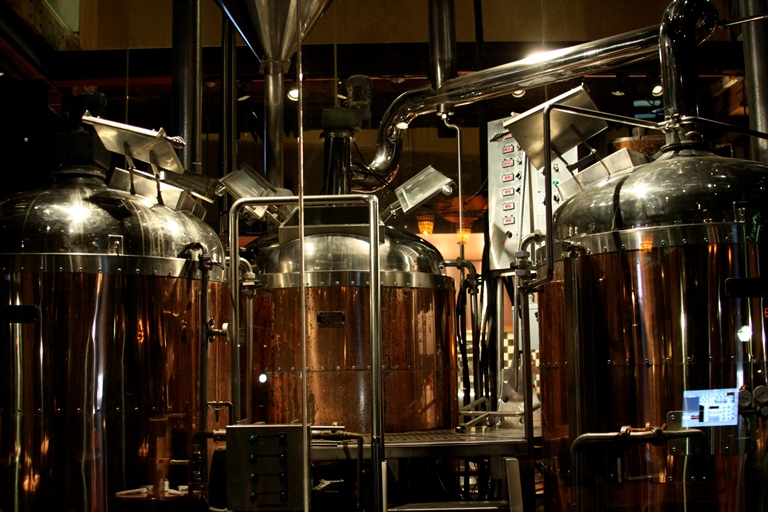When neutralization tanks at a German beer production facility were found to have extensive internal corrosion damage, there were two options: replace the tanks or rehabilitate and recoat the inside of them. Replacing the tanks would require lengthy downtime at the brewery and would be very expensive and labor-intensive. While coating the tanks seemed like the better option, was there a coating system that could stand up to the intense chemical exposure inside? Could they find a solution to save the day — and the beer?
Corrosive Chemicals = Corroded Steel
In a beer production facility, neutralization tanks are important components for the safe environmental disposal of effluents (aka liquid waste) that is generated during the beer-making process. These effluents reach the neutralization tank from the brewing water treatment, and chemicals, such as nitric acid and sodium hydroxide solutions combined with additives and sour detergents, are piped into the chambers of the tank to attain the required pH balance for safe disposal.
After 60 years of service, the internal lining of the two steel neutralization tanks at this facility had finally deteriorated to the  point that the problem needed to be addressed. There was general pitting corrosion from constant exposure to acid in areas of coatings failure, as well as galvanic corrosion throughout the interiors of the tanks.
point that the problem needed to be addressed. There was general pitting corrosion from constant exposure to acid in areas of coatings failure, as well as galvanic corrosion throughout the interiors of the tanks.
At first, the brewery contemplated replacing the tanks, but soon realized that this option would be much too complex and costly. The cellar where the tanks are located is constructed in such a way that the two tanks would need to be completely disassembled to remove them from the premises. They’re large; one is 39 feet long (12 m) and the other is 29 feet long (9 m) and both have a diameter of more than 8.5 feet (2.6 m). With this in mind, as well as the fact that new tanks would also have to be disassembled, moved into the cellar, and then reassembled, it was decided that repairing the corroded steel and then coating it with a corrosion-resistant material designed for surfaces operating under immersion conditions would be the wisest choice.
We Have a Winner!
The brewery commissioned the testing of five Belzona products to verify their chemical resistance. According to a Belzona representative, these five materials were tested by a known German manufacturer of disinfectant agents to verify their chemical resistance to various acidic and basic chemical solutions over a period of six months. Belzona 5811 (Immersion Grade) displayed the best results, with the aggressive chemical exposure causing no alteration to the material. As stated by a company representative, Belzona 5811 is a solvent-free two-part epoxy coating and can be brush- or spray-applied.
With the coating system chosen, it was time for Christian Warga of Karl Schumacher GmbH and his crew to come in and get the job done as efficiently as possible. “The timeframe for coating the tanks was very small; we had a maximum of 12 days for coating,” said Warga. In addition to a tight schedule, the crew also had to contend with an extremely small access space. According to Warga, the entry into the tank chambers was through oval openings that were less than 2  feet (60 cm) around. And of course, given that the work was to be conducted inside steel tanks, all procedures for confined space entry were observed. “In addition to the normal PPE [personal protective equipment] for coating and blasting, we had an air filter system and full-face masks with external oxygen,” explained Warga.
feet (60 cm) around. And of course, given that the work was to be conducted inside steel tanks, all procedures for confined space entry were observed. “In addition to the normal PPE [personal protective equipment] for coating and blasting, we had an air filter system and full-face masks with external oxygen,” explained Warga.
The nine-man crew began the job by grit-blasting the steel substrate, and then they applied Belzona 1111. According to Belzona, that product is a solvent-free repair composite safe for use in confined spaces. Belzona 1111 is a two-part epoxy resin reinforced with silicon steel alloy that will not corrode and is resistant to a wide range of chemicals. This material was used to resurface the heavily pitted areas and to profile corners and angles.
Once the Belzona 1111 was installed, the crew stripe-coated all edges and weld seams with Belzona 5811 to minimize the potential for coatings failure in these critical areas. It was then time to apply the Belzona 5811 to all surfaces inside the tank using an airless sprayer. The crew installed two coats of the material for a total thickness of approximately 16 mils (406 microns).
As stated by a Belzona representative, under normal ambient conditions, full chemical cure of the Belzona 5811 takes about seven days. Because of the desired turnaround time, it was decided to bring in a diesel heating system to accelerate the curing time. Hot air was blown into the tanks, and within three days the coating system achieved its full chemical resistance.
A Toast to Success
At this time, a quality control inspection showed that the specified coating thickness had been achieved and that the system had no holidays. The brewery was ready to put the tanks back into operation only nine days after the start of the project.
Thanks to an expert crew and a high-performance coating system with excellent chemical resistance, this beer-making facility saved a great deal of money, time, and resources. Cheers to a job well-done!
